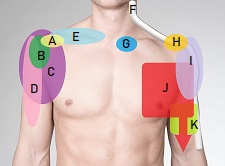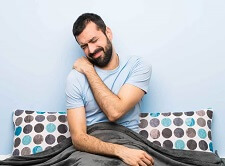- Home
- Common Shoulder Problems
- Labrum Tear
Shoulder Labrum Tear
Written By: Chloe Wilson BSc (Hons) Physiotherapy
Reviewed By: SPE Medical Review Board
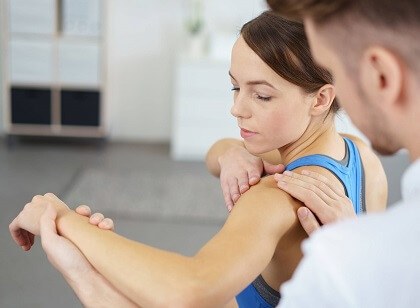
A shoulder labrum tear is a common cause of shoulder pain and instability.
The shoulder labrum is a special ring of cartilage that deepens the shoulder joint and helps to improve how the shoulder bones fit together.
Also known as the glenoid labrum, it is supported by various ligaments and tendons to increase shoulder stability and function.
Damage to the shoulder labrum causes pain and instability which can lead to partial or complete shoulder dislocation or make the shoulder more prone to other injuries such as impingement syndrome.
Here we will look at the common causes, symptoms and treatment options for the different types of shoulder labrum tear and how to make a great recovery from a torn labrum.
What Is The Shoulder Labrum?
To understand the significance of the glenoid labrum and the potential impact of a shoulder labrum tear, we first need to know a little bit about shoulder anatomy.
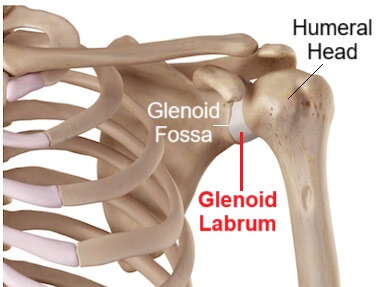
The shoulder is a ball and socket joint, known as the glenohumeral joint, made up of the:
- Humeral Head: the round head at the top of upper arm bone
- Glenoid Fossa: a shallow socket on the side of shoulder blade
The shoulder “socket” is very shallow and the “ball” is very large in relation to it with a surface area, around 4 times larger. Imagine a football resting on a golf tee! This all means there is very little bony overlap, known as congruity, at the joint.
The advantage of this is that it allows a lot of movement. In fact, the shoulder is the most mobile joint in the whole body. It can move through a huge range in multiple directions. But the problem is, it also makes the joint very unstable. And that’s where the glenoid labrum comes in.
The glenoid labrum is a special ring of cartilage that runs round the edge of the shoulder socket. It is thicker, stronger and more fibrous than normal cartilage, providing a flexible but firm grip on the head of humerus. The glenoid labrum increases the surface area of the joint and deepens the socket by around 50%, helping the ball and socket to fit together better which greatly improves joint congruity and stability without the loss of flexibility.
A number of the shoulder ligaments and rotator cuff tendons attach to various points on the glenoid labrum which helps to reinforce it and provide even greater stability.
Causes Of Shoulder Labrum Tears
Damage to the glenoid labrum is known as a shoulder labrum tear. Labrum tears may be caused by a one-off injury or repetitive wear and tear on the glenoid labrum.
Common causes of a shoulder labrum tear include:
- Direct Blow: to the shoulder e.g. sporting tackle
- Fall: particularly when landing on an outstretched arm
- Sudden Pull: at the arm e.g. lifting something heavy
- Sudden Reach: quickly reaching out for something e.g. to stop yourself from falling
- Repetitive Friction: on the labrum, most typically from doing lots of overhead work
- Overhead Sports: such as racket sports, throwing sports and weight-lifting
- Degeneration: wear and tear of the cartilage due to aging
- Dislocation: the labrum is often torn with shoulder dislocation injuries
Torn Shoulder Labrum Symptoms
Common symptoms of a shoulder labrum tear include:
- Shoulder Pain: aching pain in and around the shoulder that gets worse with overhead activities
- Instability: the shoulder may feel unstable or like you don’t trust it. In severe cases the shoulder may partially or fully dislocate
- Sharp Pain: when moving your arm if the labrum gets pinched
- Unusual Sensations: Catching or grinding sensation when moving the arm
- Strange Noises: Audible clicking or popping with shoulder movements
- Weakness: the shoulder may not feel as strong as usual
- Stiffness: Shoulder movements may be limited
- Swelling: a pocket of swelling may develop around a shoulder labrum tear known as a paralabral cyst
The symptoms of a torn shoulder labrum will depend on which part of the labrum is damaged, the severity of the tear and whether any other structures were damaged at the same time.
Types Of Shoulder Labrum Tear
There are three main types of shoulder labrum tear depending on where the damage is:
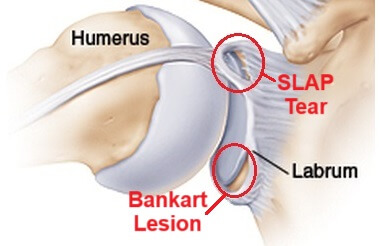
- SLAP Tear: a tear in the upper part of the glenoid labrum running front to back (Superior Labrum Anterior to Posterior). SLAP tears are typically associated with bicep tendon injuries
- Bankart Lesion: a tear in the lower part of the glenoid labrum. Bankart lesions are typically associated with shoulder dislocations
- Posterior Labrum Tear: a tear at the back of the glenoid labrum aka Reverse Bankart Lesion. This is the least common type of torn shoulder labrum
Shoulder labrum tears may occur:
- Within or along the edge of the glenoid labrum: most frequent type of glenoid labrum tear, particularly over the age of 40. May not cause any noticeable symptoms
- Where the biceps tendon attaches: at the top of the glenoid labrum
- Where it attaches to the bone: the labrum may become completely detached and a small fragment of bone may come with it. Most common when the shoulder subluxes or dislocates
Each type of shoulder labrum tear will present slightly differently, depending on the extent of damage – find out more in the SLAP Tear and Bankart Lesion articles.
Diagnosing Glenoid Labrum Tears
If you doctor suspects you have a shoulder labrum tear, they will carry out a physical examination and may perform various tests such as the Active Compression Test, Speed Test or the O’Brien Test.
They may also send you for an MRI or CT-arthrogram. These tests are not always accurate and in some cases the best way to diagnose a torn shoulder labrum is with an arthroscopy – keyhole surgery where a camera is inserted into the joint. An MRI will show any cysts that have formed due to a labrum tear.
Treatment For A Glenoid Labrum Tear
Shoulder labrum tear treatment will depend on which kind of tear there is, how severe the tear is and whether other structures in an around the shoulder have been damaged as well.
Treatment for a shoulder labrum tear will usually involve:
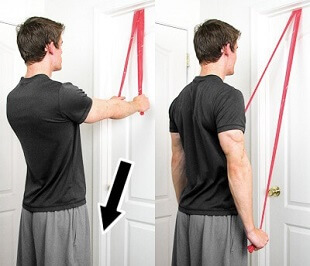
- Medication: pain relief and anti-inflammatories
- Rest: avoid aggravating activities
- Rotator Cuff Exercises: Strengthening the rotator cuff muscles is really important after a shoulder labrum tear to help you regain shoulder stability and mobility
- Scapular Stabilization Exercises: the shoulder blade muscles play a really important role in shoulder stability so exercises that target the muscles around the scapula are really important with a torn shoulder labrum.
If there is only a small glenoid labrum tear or some minor fraying, it can usually be treated non-operatively. However if there is a large tear in the glenoid labrum, it has detached from the bone or surrounding structures such as the biceps tendon or shoulder ligaments have also been damaged then surgery may be necessary.
Do I Need Surgery?
Many cases of shoulder labrum tears will heal naturally but in some cases surgery will be necessary to reattach the torn labrum, ligaments and tendons to the bone. Surgery for a torn shoulder labrum is most common in younger people who want to return to sports.
Shoulder labrum tear surgery may be advised for:
- Ongoing Symptoms: if shoulder pain and instability persists after 3-6 months of rehab
- Recurrent Dislocation: if the shoulder keep partially or fully dislocating then surgery will be advised
- High-Level Athletes: who compete in overhead sports may require surgery
Surgery is done arthroscopically – keyhole surgery where the surgeon removes any damaged parts of the labrum and, if necessary, reattaches it to the bone. If there are any shoulder cysts associated with the labrum tear, they will be removed.
You may need to wear a sling initially and will work on a progressive rehab programme with a physical therapist working on rotator cuff and shoulder stabilisation exercises. Shoulder labrum surgery has an excellent success rate and full recovery usually takes 3-6 months.
You can find out lots more about what happens during surgery and the recovery process in the following articles:
- SLAP Tear: Causes, Treatment, Surgery & Recovery
- Bankart Lesion: Causes, Treatment, Surgery & Recovery
Shoulder Labrum Tear Summary
A shoulder labrum tear is where there is damage to the special ring of cartilage found around the edge of the shoulder socket.
Glenoid labrum tears can lead to ongoing problems with pain and instability at the shoulder and may result in a shoulder cyst.
A tear is the upper portion if the glenoid labrum is known as a SLAP Tear.
A tear in the lower portion of the glenoid labrum is known as a Bankart Lesion.
Many cases can be treated at home with a combination of rest, medication and a rehab programme.
If the symptoms of a glenoid labrum tear persist then surgery may be required.
Rotator Cuff exercises and scapular stability exercises are a vital part of rehab following a shoulder labrum tear, whether or not you need surgery.
Related Articles
Medical & Scientific References
- British Medical Journal. Outcomes in patients with glenoid labral lesions: a cohort study. M. Zughaib, C. Robbins, B. Miller, J. Gagnier
- John Hopkins Medicine: Shoulder Labrum Tear
- National Library Of Medicine: Superior labral tears of the shoulder: pathogenesis, evaluation, and treatment. J. Keener & R. Brophy
- World Journal Of Orthopedics: Superior labral anterior posterior lesions of the shoulder: Current diagnostic and therapeutic standards. D. Popp and V. Schöffl
Page Last Updated: February 11th, 2025
Next Review Due: February 11th, 2027

